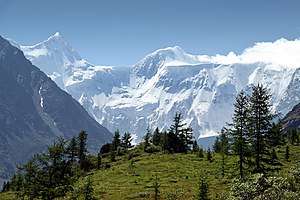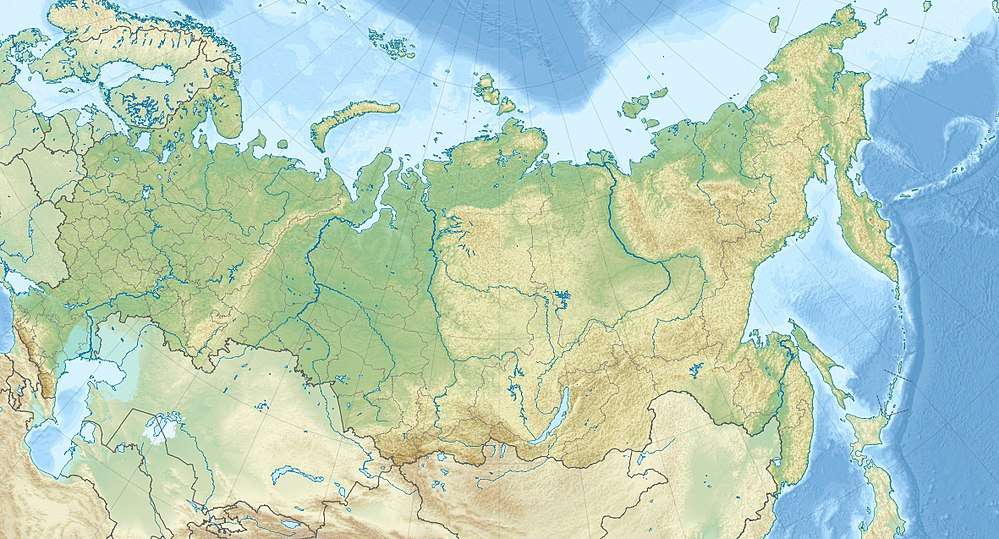Belukha Mountain
Belukha Mountain (Russian: Белуха, lit. 'whitey'; Altai: Ӱч-Сӱмер, lit. 'three peaks'; Kazakh: Мұзтау Шыңы, lit. 'icemount peak'), located in the Katun Mountains, is the highest peak of the Altai Mountains in Russia and the highest of the system of the South Siberian Mountains.[2] It is part of the World Heritage Site entitled Golden Mountains of Altai.[3]
| Belukha Mountain | |
|---|---|
 Belukha mountain 2006 | |
| Highest point | |
| Elevation | 4,506 m (14,783 ft) [1] |
| Prominence | 3,343 m (10,968 ft) [1] Ranked 58th |
| Isolation | 668 km (415 mi) |
| Listing | Ultra |
| Coordinates | 49°48′27″N 86°35′24″E [1] |
| Geography | |
 Belukha Mountain  Belukha Mountain Belukha Mountain (Altai Republic) | |
| Parent range | Altai Mountains |
| Climbing | |
| First ascent | 1914 by B.V. Tronov & M.V. Tronov |
| Easiest route | basic rock/snow climb |
Located in the Altai Republic, Belukha is a three-peaked mountain massif that rises along the border of Russia and Kazakhstan, just a few dozen miles north of the point where this border meets with the border of China. There are several small glaciers on the mountain, including Belukha Glacier. Of the two peaks, the eastern peak (4,506 m, 14,784 ft.) is higher than the western peak (4,440 m, 14,567 ft.).
Belukha was first climbed in 1914 by the Tronov brothers. Most ascents of the eastern peak follow the same southern route as that taken in the first ascent. Though the Altai is lower in elevation than other Asian mountain groups, it is very remote, and much time and planning are required for its approach.
In the summer of 2001, a team of scientists traveled to the remote Belukha Glacier to assess the feasibility of extracting ice cores at the site. Research was carried out from 2001 to 2003: both shallow cores and cores to bedrock were extracted and analyzed (Olivier and others, 2003; Fujita and others, 2004). Based on tritium dating techniques, the deeper cores may contain as much as 3–5,000 years of climatic and environmental records. A Swiss-Russian team also studied the glacier. [4]
Since 2008, one is required to apply for a special border zone permit in order to be allowed into the area (if travelling independently without using an agency). Foreigners should apply for the permit to regional FSB border guard office two months before the planned date.[5][6]
See also
- List of Altai mountains
- List of Ultras of Central Asia
- List of glaciers of Russia
References
![]()
- "The Central Asian Republics Ultra Prominence Page" Listed as "Gora Belukha" on Peaklist.org. Retrieved 2011-11-20.
- "Mount Belukha". Encyclopædia Britannica. Retrieved 31 July 2007.
- "Golden Mountains of Altai". UNESCO. Archived from the original on 18 August 2007. Retrieved 31 July 2007.
- L. DeWayne Cecil; David L. Naftz; Paul F. Schuster; David D. Susong & Jaromy R. Green. "Glaciers of Asia— THE PALEOENVIRONMENTAL RECORD PRESERVED IN MIDDLE LATITUDE, HIGH-MOUNTAIN GLACIERS—AN OVERVIEW OF THE U.S. GEOLOGICAL SURVEY EXPERIENCE IN CENTRAL ASIA AND THE UNITED STATES" (PDF). US Geological Survey (public domain). Retrieved 13 May 2012.
- Lonely Planet. "Thorn Tree - New border zone regulation/ Altai concern". www.lonelyplanet.com.
- "dont you ever mind :: the great outdoors :: altai, russia, 2008". dontmind.freeshell.org. Archived from the original on 3 March 2016. Retrieved 8 May 2009.
| Wikimedia Commons has media related to Belukha Mountain. |